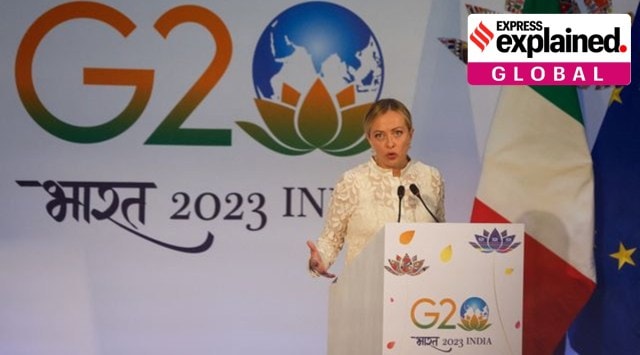Italy to walk out of China’s Belt and Road Initiative? Its economic, strategic reasons; significance
At a press conference after the G20 summit in New Delhi, Italy's PM Giorgia Meloni said a final decision on leaving the Belt and Road Initiative was yet to be taken. What reasons does Italy have to leave China's flagship initiative?
 Italian Prime Minister Giorgia Meloni at a press conference on the sidelines of the G20 Summit in New Delhi, on September 10. (Photo: Reuters)
Italian Prime Minister Giorgia Meloni at a press conference on the sidelines of the G20 Summit in New Delhi, on September 10. (Photo: Reuters) After Italian media reported on Sunday (September 10) that Italy was planning to leave China’s Belt and Road Initiative (BRI), the country’s prime minister Giorgia Meloni said later in the day that “there was more to Italy’s relationship with China than the BRI”, according to Reuters.
Meloni clarified that a final decision on whether to leave the BRI was still to be taken.
Italy is the only G7 country (the grouping of advanced economies of US, the United Kingdom, Canada, France, Germany, Italy, and Japan, with the European Union as a “non-enumerated” member) to sign up for the BRI, which it did in 2019.
China’s ambitious Belt and Road Initiative is a massive trade and infrastructure network that seeks to connect the country with the West in a model based on the ancient Silk Route. Under the initiative, pushed by the Xi Jinping regime, China has built or financed bridges, roads, ports, and even laid down digital connectivity networks in partner countries.
What happened during the G20 summit?
Meloni met Chinese Premier Li Qiang on Saturday (September 9) on the sidelines of the G20 summit in New Delhi. On Sunday, reports emerged that Italy was planning to walk out of the BRI, but, in a bid to stem backlash from Beijing, would seek to revitalise another strategic partnership agreement with China it had signed in 2004.
On Sunday, in a press conference at the end of the G20 summit, Meloni said, “There are European nations which in recent years haven’t been part of the Belt and Road but have been able to forge more favourable relations (with China) than we have sometimes managed. The issue is how to guarantee a partnership that is beneficial for both sides, leaving aside the decision that we will take on the BRI.”
She also said the Chinese had renewed an invitation for her to visit Beijing but no date had been set. The Italian government has also been invited to a BRI Forum that China will host in October, she added.
Is this the first time Italy has indicated it may leave BRI?
No. Sections of Italian political leaders have complained that the agreement has benefitted China more than Italy. In July this year, Italian Defence Minister Guido Crosetto had told the newspaper Corriere della Sera that the country wanted to “walk back [from the BRI] without damaging relations with Beijing”.
“The choice to join the Silk Road was an improvised and wicked act, made by the government of Giuseppe Conte, which led to a double negative result. We exported a load of oranges to China, they tripled exports to Italy in three years,” said Crosetto in the interview, as quoted by Politico.
Why does Italy want to leave the BRI?
Italy had joined the BRI at a time it was desperate for investment and infrastructure building, having survived three recessions in 10 years. Its government at the time did not share warm relations with the EU, and was happy to turn to China for the funds it could pump in.
Four years later, the agreement hasn’t done much for Italy.
According to figures from Council on Foreign Relations, Chinese FDI in Italy dropped from $650 million in 2019 to just $33 million in 2021. In fact, the country invested far more in non-BRI countries in Europe. In terms of trade, since joining BRI, Italy’s exports to China increased from 14.5 billion euros to a mere 18.5 billion euros, while Chinese exports to Italy expanded from 33.5 billion euros to 50.9 billion euros.
However, despite these obvious problems, if Italy walks out of the deal, the reason won’t be just economics.
BRI amid changing geopolitics
For Beijing, a G7 country joining the BRI had been a big diplomatic win, and Rome walking out just ahead of the initiative’s 10th anniversary will be a loss of face.
This will be in line with Europe’s increasingly cautious stand towards China.
While the US-China ties have been rocky for years now, many countries in Europe continued to maintain close economic and trade links with the Asian economic giant. The Russia-Ukraine war, China’s perceived staunch support of Vladimir Putin, and geopolitical rivalries taking the form of trade sanctions have forced a rethink.
In April, EU-China Comprehensive Agreement on Investment (CAI) collapsed. Last year, Estonia and Latvia quit the 17+1, China’s diplomatic push in Central and Eastern European countries. Lithuania had walked out in 2021.
Italy too has been gradually hardening its stance against Beijing, especially after Meloni came to power. As Foreign Policy reported, “Former Prime Minister Mario Draghi blocked tech transfers to Beijing and prevented Chinese takeovers of Italian companies… Meloni has gone even further, restricting a Chinese firm’s influence on Italian tiremaker Pirelli and affirming her support for Taiwan.” She has also been staunch in her support for Ukraine.
Italy has the G7 presidency next year, and walking out of the BRI will sit well with its Western allies.
The BRI, too, has attracted negative press over the years. Many countries that joined it enthusiastically now find themselves staring at a massive debt burden to China.
An analysis by the Associated Press “of a dozen countries most indebted to China — including Pakistan, Kenya, Zambia, Laos and Mongolia” found that paying back the debt “is consuming an ever-greater amount of the tax revenue…and draining foreign currency reserves”. Behind this, AP said, “is China’s reluctance to forgive debt and its extreme secrecy about how much money it has loaned and on what terms, which has kept other major lenders from stepping in to help.”
Recently, the West has come out with its own initiative for funding infrastructure projects across the world, seen as a counter to the BRI —the Partnership for Global Infrastructure Investment (PGII). Read our detailed explainer on that here.
BRI and India
India does not support the BRI, and has declined to join the project. The major reason for this is that the BRI passes through Indian territory illegally held by Pakistan.
The arm of the BRI project that links mainland China to the Arabian Sea runs from Kashgar in China’s Xinjiang Uighur Autonomous Region to Gwadar port in southwestern Baluchistan in Pakistan. The project enters Indian territory occupied by Pakistan in Gilgit Baltistan, and traverses the entire length of Pakistan from north to south before reaching the Arabian Sea.
This arm of the BRI is called the China-Pakistan Economic Corridor, or CPEC, and consists of multiple modern highway and railway projects. India has repeatedly voiced its concern and opposition to the CPEC, and flagged the violation of international law in its building by China and Pakistan.



- 01
- 02
- 03
- 04
- 05



































